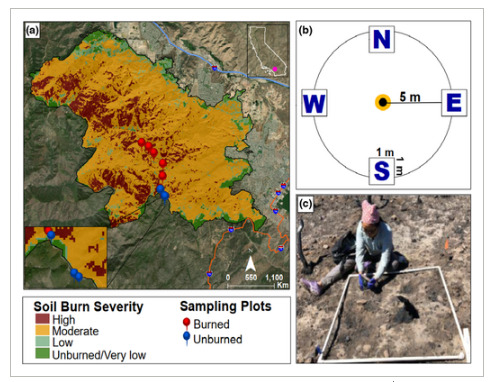メガファイアの死角を微生物が蘇らせる? Can microbes revive megafire dead zones?
2023-02-07 カリフォルニア大学リバーサイド校(UCR)
◆2018年にオレンジ郡とリバーサイド郡で23,000エーカー以上を焼いたホーリーファイヤー。炎が時間とともにバクテリアや菌類にどのような影響を与えたかを理解したいと思い、UCRの菌類学者シドニー・グラスマンは、研究者チームを燃焼痕に導きました。
◆研究者たちはその後1年間に9回、焼け跡を訪れ、炭化した土と近くの未燃焼の土のサンプルを比較した。その結果、火事の後、微生物の総量は50~80%減少し、最初の1年間は回復しなかったことが、このたび『Molecular Ecology』誌に発表された。
◆しかし、ある種の生物は生き延びた。「ある種の生物は存在量が増加し、実際、焼失した土壌の存在量には時間の経過とともに実に急激な変化が見られました」と、グラスマンは語った。「焼却されていない土壌では、まったく変化がありませんでした。
◆生き残ったのは、一種類のバクテリアや菌類だけではありません。むしろ、焼失後の最初の年に、さまざまな微生物が交互に焼失した土壌を支配していたのです。「時間の経過とともに、微生物には興味深い明確な変化が見られました。ある種が減少すると、別の種が増加したのです」とグラスマンは言う。
◆初期には、火災や高熱に強い微生物が見つかっています。その後、多くの胞子を持ち、微生物との競合が少ない空間を利用できる、成長の速い微生物が優勢になったようです。年末になると、木炭や窒素を多く含む火事の後の残骸を消費できる生物が優勢になる傾向があった。
◆メタノトロフと呼ばれる特定の微生物は、温室効果ガスであるメタンの分解を制御している。UCR植物病理学博士候補で本研究の筆頭著者であるファビオラ・プリド-チャベスは、火災後の微生物でメタン代謝に関わる遺伝子が2倍に増えていることに気づきました。
◆「この発見は、火災後の微生物がメタンを「食べて」炭素とエネルギーを得ることを示唆しており、温室効果ガスの削減に貢献できる可能性があります」とPulido-Chavezは述べています。
◆研究者らは、発見した菌類や細菌が、ユニークで多様な形質の結果、異なる時点で繁栄することができたのか、それとも土壌に見られた変化には別の理由があるのか、引き続き検証を続けている。
<関連情報>
- https://news.ucr.edu/articles/2023/02/07/fungi-and-bacteria-are-binging-burned-soil
- https://onlinelibrary.wiley.com/doi/10.1111/mec.16835
森林火災後の初年度の細菌および菌類による急速な後継者育成の動き Rapid bacterial and fungal successional dynamics in first year after chaparral wildfire
M. Fabiola Pulido-Chavez, James W. J. Randolph, Cassandra Zalman, Loralee Larios, Peter M. Homyak, Sydney I. Glassman
Molecular Ecology Published: 29 December 2022
DOI:https://doi.org/10.1111/mec.16835

Abstract
The rise in wildfire frequency and severity across the globe has increased interest in secondary succession. However, despite the role of soil microbial communities in controlling biogeochemical cycling and their role in the regeneration of post-fire vegetation, the lack of measurements immediately post-fire and at high temporal resolution has limited understanding of microbial secondary succession. To fill this knowledge gap, we sampled soils at 17, 25, 34, 67, 95, 131, 187, 286, and 376 days after a southern California wildfire in fire-adapted chaparral shrublands. We assessed bacterial and fungal biomass with qPCR of 16S and 18S and richness and composition with Illumina MiSeq sequencing of 16S and ITS2 amplicons. Fire severely reduced bacterial biomass by 47%, bacterial richness by 46%, fungal biomass by 86%, and fungal richness by 68%. The burned bacterial and fungal communities experienced rapid succession, with 5–6 compositional turnover periods. Analogous to plants, turnover was driven by “fire-loving” pyrophilous microbes, many of which have been previously found in forests worldwide and changed markedly in abundance over time. Fungal secondary succession was initiated by the Basidiomycete yeast Geminibasidium, which traded off against the filamentous Ascomycetes Pyronema, Aspergillus, and Penicillium. For bacteria, the Proteobacteria Massilia dominated all year, but the Firmicute Bacillus and Proteobacteria Noviherbaspirillum increased in abundance over time. Our high-resolution temporal sampling allowed us to capture post-fire microbial secondary successional dynamics and suggest that putative tradeoffs in thermotolerance, colonization, and competition among dominant pyrophilous microbes control microbial succession with possible implications for ecosystem function.


